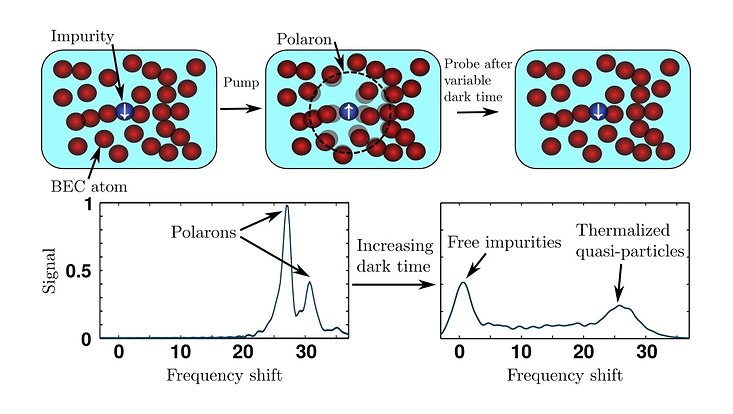Imaging of Matter
Scientists propose a new technique for the investigation of quasi-particles
17 September 2020

Photo: UHH, AG Schmelcher
The formation and properties of polarons drastically influence the conductivity of technologically relevant materials. Examples include the organic semiconductors found in the ecologically-friendly plastic solar cell technologies. Regarding fundamental physics, polarons are even conjectured to play a crucial role in high-temperature superconductivity. A collaboration of researchers at the Cluster of Excellence “CUI: Advanced Imaging of Matter” at Universität Hamburg and the Okinawa Institute of Science and Technology proposes a powerful spectroscopic technique that is able to capture and identify the intriguing correlation properties of these quasi-particles within the realm of ultracold quantum simulation. Their work, which has now been published in “Physical Review Research”, paves the way for a fruitful transfer of knowledge between the realms of ultrafast dynamics, ultracold atoms and condensed matter physics.
An electron moving through a material attracts the heavy ions that form the crystal and as a consequence forces the latter to oscillate around their equilibrium positions. If the electron and the vibrations of the crystal ions are coupled strongly enough then a quasi-particle called polaron is formed. Quasi-particles are composite structures that possess different physical properties from the ones corresponding to their constituents. The polarons are largely technologically relevant since, for instance, their large mass in semiconductors dramatically changes the conduction properties of these materials. Besides being of fundamental importance to material science, similar quasi-particles appear in distinct systems covering almost all fields of physics.
However, Polarons are notoriously difficult to be captured by computer simulations. Despite intense studies, the fundamental properties and associated correlation processes are not fully understood. “The quantum simulation of polarons necessitates the development of novel techniques for addressing the intricate properties of quasi-particles,” says Prof. Peter Schmelcher from the Institute of Laser Physics at Universität Hamburg.
Pump-probe spectroscopy of ultracold impurities
The researchers from Hamburg and Okinawa have ample previous experience in understanding theoretically the properties of ultracold polarons. Among others, they have demonstrated in their past studies that the external confinement imposed in ultracold atom experiments significantly affects the behavior of polaronic excitations, leading for instance to their death for strong repulsive impurity-medium interactions, a phenomenon they have dubbed as “temporal orthogonality catastrophe”. In their new work the researchers claim that the combination of the ultracold atom techniques with the ones usually employed in ultrafast spectroscopy provides the proper tools for addressing and demonstrating such correlation related phenomena, emerging in ultracold polarons.
The proposed pump-probe spectroscopy scheme relies on the preparation of a non-equilibrium state of the system by a radiofrequency pump pulse, which results in the embedding of strongly interacting impurities in a BEC. Subsequently, the system is allowed to evolve in the absence of radiofrequency fields for a variable (dark) time, allowing for the formation of polarons and the development of their dynamics. Then, after this dark time, the system is interrogated by a time-delayed probe pulse, which transfers the impurity to a state that is non-interacting with its bosonic environment. For switching the interactions on and off the protocol relies on impurity atoms with spin-dependent interactions with their environment, which can be readily implemented in ultracold atom experiments.
The protocol allows for the identification of special effects
Within their study, the formation of coherently attractive and repulsive polarons can be inferred by properly analyzing the spectra of the probe pulse for small dark times, while for longer evolution times intriguing phenomena such as the above-mentioned temporal orthogonality catastrophe or the thermalization of the ensuing impurities can be clearly observed. In addition, the proposed protocol allows for the identification of long-sought-after-effects, including the induced attraction among polarons. In particular, when two impurities are close to one another each one experiences distortions of the environment caused by the other impurity, a mechanism resulting from their mutual attraction. “This effect is also of crucial importance to condensed-matter physics,” says Prof. Schmelcher. “It provides an attraction mechanism between two electrons, that has been proposed to explain a variety of phenomena, with the most striking one being the high-temperature superconductivity. However, the observation of such an attraction in ultracold atom setups has been elusive.”
The application of pump-probe spectroscopy for the study of polarons constitutes only one out of the many possibilities of this method in the ultracold atom realm. Indeed, a similar method has been applied recently for the study of ferromagnetic properties of repulsively interacting Fermi gases which are notoriously difficult to identify. But as Prof. Schmelcher states there is a “bright future for the application of related methods in a plethora of different scenarios”. A few characteristic examples of such possible extensions involve the study of the recondensation dynamics in the excited bands of optical lattices and also in the vibrational dynamics of ultra-long range Rydberg molecules, it will enable the identification of the lifetime of such excitations.
Publication
S. I. Mistakidis, G. C. Katsimiga, G. M. Koutentakis, Th. Busch, and P. Schmelcher
"Pump Probe Spectroscopy of Bose Polarons: Dynamical Formation and Coherence"
Phys. Rev. Res. 2, 033380 (2020)


